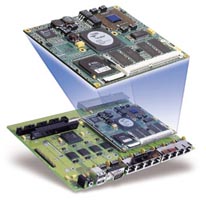Advantech, Adlink hitch a ride on Kontron’s ETXexpress
Aug 9, 2004 — by LinuxDevices Staff — from the LinuxDevices Archive — 1 views Kontron announced the addition of two passengers — Advantech and Adlink — on its ETXexpress bus. The compact computer module standard was initially unveiled by Kontron last November.
Kontron announced the addition of two passengers — Advantech and Adlink — on its ETXexpress bus. The compact computer module standard was initially unveiled by Kontron last November.
The new computer module spec is an evolutionary successor to the earlier ETX standard, which was developed by Kontron. Whereas ETX makes use of PCI as its principal system bus, ETXexpress leverages recently introduced PCI Express bus technology as a high speed system bus, along with several emerging peripheral interface standards.

Kontron mock-up of ETXexpress module
Kontron provided the following overview of the proposed ETXexpress:
ETXexpress will support up to eight PCI Express x1 Lanes and PCI Express Graphics as well as established hardware solutions based on current busses such as 32-bit PCI and ISA bus (via a LPC). A 10/100/1000 Mbps Ethernet port provides fast connectivity to LAN/WAN, and up to eight USB 2.0 ports provide fast interfaces for external drives/flash, keyboard, mice, and other peripherals. ETXexpress modules also provide interfaces that are always located in the same physical position on each board, guaranteeing scalability between modules. These include serial ATA, parallel ATA, LVDS Multi Media ports, as well as an ACPI (Advanced Configuration and Power Interface) for optimized power management.
The new standard will be initially offered in a 90 x 125 mm form-factor. Signals are brought out via high pin-count surface mount connectors that permit data transmission rates of up to 5 GHz. Six mounting holes on the board provide resistance to shock and vibration. The thermal coupling system incorporates a standardized heat spreader, the same as with ETX.
 According to Kontron, ETXexpress (and ETX) computer modules are meant to be installed on an application specific baseboard much like an integrated circuit component, in a “host” site comprised of several low profile, surface-mount connectors. The baseboard provides the drive electronics and physical connectors for the I/O originating on the computer module. Additional I/O and application-specific subsystems can be integrated on the baseboard, designed as peripherals to the computer module using the various bus and interface signals originating on the module.
According to Kontron, ETXexpress (and ETX) computer modules are meant to be installed on an application specific baseboard much like an integrated circuit component, in a “host” site comprised of several low profile, surface-mount connectors. The baseboard provides the drive electronics and physical connectors for the I/O originating on the computer module. Additional I/O and application-specific subsystems can be integrated on the baseboard, designed as peripherals to the computer module using the various bus and interface signals originating on the module.
This article was originally published on LinuxDevices.com and has been donated to the open source community by QuinStreet Inc. Please visit LinuxToday.com for up-to-date news and articles about Linux and open source.